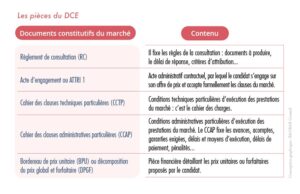Public procurement is constantly evolving, and is becoming increasingly complex due to the diversity of the players involved and the directives to be followed, depending on the activity. Against this backdrop, knowing who you are dealing with has become a priority for many companies that want to respond to and win public tenders. So how do you position yourself in relation to a public purchaser? What are the best practices for responding to and winning public tenders? Muriel Guillemot, a specialist in purchasing management, explains.

Public tenders are processes by which government or public bodies (e.g. the hospital sector) solicit proposals from companies for the supply of goods, services or works. The aim is to ensure transparency, competition and fairness in the award of public contracts. Invitations to tender can vary in size and complexity, from local contracts to major national projects.
Understanding the challenges of public tenders
In 2022, the value of public contracts reached record level of 160 billion euros. The State and the hospital sector account for 26.9 % of these contracts, local authorities 41.22 % and other purchasers (public companies, contracting entities, etc.) 31.8 %. In addition, the proportion of social and environmental clauses is increasing (22.3 % compared with 13.2 % in 2021; 29.2 % compared with 18.7 %). Proof that public procurement is increasingly integrating sustainable development.
In this context, public tenders are of strategic importance to companies. They represent commercial opportunities, often with large budgets, and offer companies the chance to develop their customer portfolio. Similarly, winning public contracts can enhance a company's reputation and credibility, demonstrating its ability to meet rigorous standards and understand the social and environmental clauses to be included. With this in mind, the aim is to move closer to the objectives of the National Plan for Sustainable Procurement 2022-2025 drawn up by the General Commission for Sustainable Development (CGDD). Another advantage for companies is access to new geographic or sectoral markets.
Knowing how to position yourself in a public procurement market is not something you can improvise. You need to think things through beforehand, and then take operational steps. The first step is to ask yourself the right questions and analyse the tender documents carefully.
Understanding public tenders
The DCE is the file issued to economic operators free of charge by the contracting authority/entity in connection with the award of a public contract. It comprises all the documents drawn up by the contracting authority or entity.public purchaser necessary for the consultation of candidates and the performance of the contract. For example: the consultation rules (RC), the general administrative clauses (CCAG).
Familiarise yourself with the vocabulary of public procurement
AAPC: avis d'appel public à la concurrence (public invitation to tender)
RC: consultation regulations
ATTRI1: Commitment form (ex-DC 3)
CCAG: general administrative clauses
CCAP: special administrative clauses
CCTP: special technical specifications
DUME: Single European Market Document
DPGF, BPU, DQE: financial documents (breakdown of the total and fixed price, unit price list, quantity and estimate)
This documentation is often very detailed. It is therefore crucial for companies to have a good understanding of the constituent elements of the DCE in order to respond appropriately and competitively. They must be able to understand the technical requirements, deadlines, evaluation criteria and contractual terms and conditions.

Identify the entity issuing the call for tenders
First of all, you need to know who you are going to talk to. Who is the person we are talking to during the consultation or invitation to tender? Is it a purchasing professional or a trade professional?
This data is essential for companies to better understand the behaviour of the target audience, to better understand and personalise their responses, and to weigh up the strategic interest of positioning themselves on this call for tenders.
You need to ask yourself whether the public purchaser has any knowledge of the business environment. But also: does he wear two hats as a contract writer? What sector do they come from? Are they in touch with the market? What is their relationship with the specifier? All these questions will lead to a different positioning: business, legal, economic or all at once.
"The public purchaser must wear many hats".
Once the specifier has been identified, it is important to develop a constructive relationship with them. And with good reason: the closer you are to the public purchaser, the more information you will be able to obtain about the tender in question.
Understanding your objective and your needs
It is also important to have a clear understanding of the purpose of the call for tenders and the customer's needs beforehand - and not at the time of the response. You must not make any mistakes in expressing your needs. The pitfall to avoid: copying and pasting the special technical specifications (CCTP).
Examine the conditions for participation
Examine the eligibility criteria and the administrative and legal requirements to ensure that the company is compliant. This means mastering the documentary and administrative aspects. And above all: knowing the principles of public procurement.
"The salesperson responding to a public tender must understand the concept of influence strategy".
Examine the tender timetable
Familiarise yourself with the steps involved in submitting a proposal, the formats required and the documents to be provided. Identify the key dates: the deadline for receiving bids, the date for opening bids and any information meetings.
Understanding assessment criteria
Analyse the criteria on which the proposals will be assessed: cost, technical skills, deadlines, etc.
Analysis of the consultation file: what needs to be done
Resources required
Identify the human, material and financial resources needed to meet the requirements of the project.
In-depth understanding
Ensuring a thorough understanding of the customer's needs in order to formulate a relevant proposal.
Compliance
Ensure that every aspect of the proposal complies with the requirements of the consultation file and the specifications. Errors or omissions may result in the proposal being rejected.
Risk assessment
Identify any risks and uncertainties associated with the project.
Careful analysis of these elements is essential to formulate a proposal that is precise, competitive and in line with the customer's expectations. This will enable the company to maximise its chances of winning the contract.
Preparing well to position yourself
Before drafting your response to the call for tenders, it is important to follow a number of best practices to prepare and position yourself properly.
Selection of public tenders
Establish criteria for selecting relevant invitations to tender based on your areas of expertise, your capabilities and your business strategy. For example: contract size, location, fit with your company's skills. Set up a filtering process to quickly assess the relevance of the tenders identified.
"The salesperson has to qualify, choose and not respond to every invitation to tender.
Regular competitive intelligence
Set up regular monitoring using sources such as government websites, tender platforms, specialist media and professional networks. Also carry out competitive intelligence to understand the strengths and weaknesses of potential competitors in the context of a specific call for tenders.
Assignment of responsibilities
Assign clear responsibilities to each member of the team, from monitoring to drafting the proposal. In addition, one person in the company should have an overview. For example: the branch manager.
What about SMEs and public procurement?
SMEs have a competitive advantage over other companies. The key is to position themselves in relation to their core business. To respond to public tenders, they can also enlist the help of consultants. In fact, both parties (SMEs and those involved in public procurement) can benefit from assistance with purchasing methods. For example, I've worked with several members of the cancer institute to help them develop their purchasing skills. In fact, they now wear two hats: lawyer and buyer.
Quality control and meeting deadlines
Set up an internal quality control process to ensure that the proposal is compliant and consistent. Have independent parties review your proposal for errors and inconsistencies. Perform a final check before submission to ensure that all required documents are included. Also, be sure to submit your proposal within the deadlines stipulated in the call for tenders.
How to write an "impactful" proposal
Compliance with the rules of presentation in a call for tenders is crucial. Here are the best practices to follow when preparing your response.
Complete understanding of requirements
Make sure you fully understand the customer's needs by carefully analysing the specifications, the technical specifications (CCTP), the administrative specifications (CCAP) and the evaluation criteria (RC). The CCTP must be followed to the letter. Use the customer's specific terminology and language to demonstrate that you have understood their needs.
Clear structure of the file
Organise your dossier clearly, with a detailed table of contents for easy navigation.
Targeted, personalised response
Tailor your proposal to meet the customer's specific needs, highlighting your strengths in relation to their requirements.
Convincing executive summary
Include an executive summary highlighting the strong points of your proposal in a concise and convincing way.
Compliance with requirements
Include a formal declaration of conformity, showing that your offer meets all the specified requirements.
Solid arguments, clarity and conciseness
Back up every aspect of your proposal with solid arguments, highlighting your expertise, experience and capabilities. Write clearly and concisely, avoiding excessive jargon, and make sure each sentence has a clear purpose.
Proof of previous success
Include case studies or concrete examples demonstrating your success in similar projects.
Financial clarity
Be transparent about your cost structure, payment terms and any other relevant financial information.
Professional presentation
Make sure that the dossier is presented in a professional manner, with a neat layout and relevant visuals.
Answers to all your questions
Make sure you answer all the questions asked in the specifications. Do not leave any part of the proposal incomplete.
Differentiate yourself from the competition
Highlight what makes your commercial offer unique and better than the competition's. You can differentiate yourself by your level of satisfaction, performance and CSR (corporate social responsibility). In other words: be curious, concise, rigorous and able to work on your differentiation.
Post-response monitoring
Once you have submitted your proposal, it is necessary to maintain proactive communication with the public purchaser to obtain clarifications, if necessary. Whether positive or negative, don't hesitate to analyse feedback so that you can continually improve your process for responding to invitations to tender. Even if the response is negative, feedback will enable you to readjust what went wrong.
Things to remember: responding to a public invitation to tender is not something you can improvise. The way you approach a public purchaser is crucial to your success. You need to understand best practice in public procurement, which can simplify the management of the call for tenders, and comply with the regulations in force. However, private companies need to understand their room for manoeuvre depending on the sector of activity and adopt effective practices with all the players involved in public procurement.





